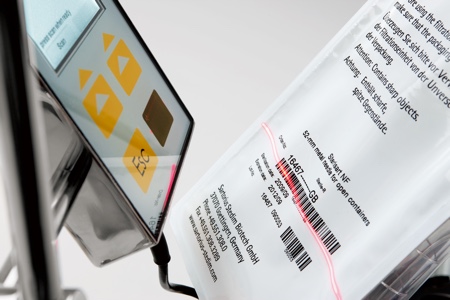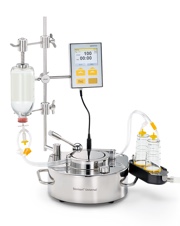The result of eye drops being contaminated with Pseudomonas aeruginosa can be a considerable loss of vision or even complete blindness, as happened to some users in Sweden in 1968. Infectious pathogens – bacteria, viruses, fungi, parasites – that find their way into the blood stream can multiply and cause blood poisoning, called sepsis, a severe immune response to pathogens or their toxins.
Minimising microbial contamination during the production of pharmaceuticals is an absolute necessity
Minimising microbial contamination during the production of pharmaceuticals is an absolute necessity. The GMP Guidelines therefore impose a steadily growing number of requirements that oblige manufacturers to guarantee drug safety by following appropriate quality assurance and quality management concepts. These GMP Guidelines deal not only with the pharmaceuticals themselves, i.e. with their production, packaging and testing, but also with the supply of all starting materials, including any machinery and equipment required. Personnel hygiene and personnel training are also core fundamentals covered by GMP Guidelines.
Another essential component of GMP requirements is to implement in-process control and final product quality control testing to detect any microbiological contamination and to monitor the bioburden.
Sterility testing for batch release
In particular, strict requirements apply to sterile formulations, i.e. parenterals intended for injection, infusion or transplantation into the human or animal body. Testing the sterility of the filled final product is an essential and a decisive criterion for approving the release of a complete batch.
Sterility testing of the final product can be carried out either by the drug manufacturer or by a certified contract lab. According to the international pharmacopeias (USP <71>, EP 2.6.1, JP 4:06, WHO (QAS / 11,413 final), sterility testing is not only to be carried out on parenterals, but is also mandatory for the release of eye drops, ointments, creams, aerosols and solids, such as surgical sutures.
The method for culturing micro-organisms to test for product sterility has existed since about 1930. It involves either filtration of the pharmaceutical product to be examined – the currently preferred method according to USP <71> or EP 2.6.1 – alternatively, if this method is not possible, direct transfer of the product to a liquid culture medium. The sterility test is performed in a controlled environment under aseptic conditions, either in an isolator that meets the requirements of a EU cGMP Grade A cleanroom, or in a laboratory Grade A cleanroom (i.e. clean bench, surrounded by a Grade B cleanroom).
Measures taken to prevent contamination of the critical area may not affect the growth of any micro-organisms present in samples undergoing sterility testing. This needs to be ensured by appropriate validation procedures, for example, bacteriostasis/fungistasis tests. To monitor the environmental conditions, methods that do not interfere with the protection of the cleanroom area are used, such as active air sampling with the MD8 AirScan. In especially critical areas, e.g. filling lines, isolators or blow-fill-seal equipment, users rely on the proven high retention and recovery rates of gelatin membrane filters to detect viruses and micro-organisms during air monitoring.
Measures taken to prevent contamination of the critical area may not affect the growth of any micro-organisms present in samples undergoing sterility testing
The demands on the sterility testing system, materials and on the personnel performing this test are very high. After all, both false-negative and false-positive results must be avoided (US Department of Health and Human Services, Food and Drug Administration, [CBER], Office of Regulatory Affairs).
According to 21 CFR 211.25, well-trained personnel are important in this regard. Therefore, lab personnel should give thought early on to the application itself as well as to its requirements and prepare a checklist or User Requirement Specification (URS). In selecting a sterility testing system, they also need to weigh process risks against the cost benefits.
Rules applying to sterility testing
The countries in which a pharmaceutical product will be sold must first be defined, since knowledge of GMP Guidelines is a fundamental requirement. For example, in almost all countries, sterility testing is performed with two culture media and two test containers. For parenterals sold in China, a three-container variant is mandatory, whereas in South America and Africa, because of the low labour costs, individual components assembled into a system part by part are more commonly used.
This individually assembled equipment, known in Germany as the ‘Schiller system’, was widespread in Europe until about 1975. Due to the time required for assembly and the risk of false-positive results, however, it is no longer used in Europe, the US or Japan.
The procedure for sterility testing is clearly regulated and requires a cleanroom-suitable pressure supply
The procedure for sterility testing is clearly regulated: it requires a cleanroom-suitable pressure supply, e.g. a peristaltic pump that conveys the liquid to be analysed into the sterility test units that filter it through an incorporated membrane. Having a nominal pore size of 0.45µm, this low-adsorption membrane in each test unit reliably retains micro-organisms.
Antibiotics and other growth-inhibiting substances are washed out by pumping rinsing fluid through the sterility testing system. If the product to be tested is in powder form, it must be made soluble by appropriate means. At the end of the process, the two test containers are sealed off on the bottom with a plug. Subsequently, the containers are each filled with the appropriate culture medium: CASO (Casein Soybean Digest) for detecting aerobic bacteria and Fluid Thioglycollate Medium for detecting anaerobic/aerobic bacteria. The permissible rinsing fluids are specified in USP <71>. Because the septa on the rinsing fluid containers or product are usually pierced more than once, the user must ensure that the needles are sharp enough to allow smooth and easy multiple puncturing.
To enable GMP-compliant work, batch traceability must be in place for all products used, including the sterility test system; preferably, however, it should be possible to scan the barcode on each package and save the data as a PDF file in accordance with 21 CFR Part 11.
For final batch release testing of sterile-labelled pharmaceuticals, Sartorius supplies Sterisart NF single-use units. These systems feature a closed design for testing bags, syringes, vials, ampoules and powders, and function according to the membrane filtration method. The objective of using Sterisart NF units is to enable reproducible, reliable sterility testing that leaves no room for false-positive or -negative results.
Recognised by the medical sector, septum technology has proven its efficacy
During the 14 days of incubation to identify any contamination or to validate a pharmaceutical product, it may be necessary to remove samples from containers aseptically or to inject fluids, e.g. penicillinase, to deactivate antibiotics with a b-lactam ring system. Today, sampling and injection are generally carried out by piercing the tube with a spike or by cutting the tubing and subsequently pipetting in the solution. This increases considerably both the risk of contamination and the risk of puncture-related injury for the user.
Risks can be avoided and sampling made much easier by using septum versions of Sterisart NF units. Recognised by the medical sector, septum technology has proven its efficacy. The septum is capped, and can be disinfected with a wipe wetted with isopropanol, if necessary. If the pharmaceutical product itself renders the medium turbid, USP <71> recommends: ‘…14 days after the beginning of incubation, transfer portions (each not less than 1mL of the medium) to fresh vessels of the same medium...’
Septum versions of sterility test units enable safe and reliable fluid transfer. The concept of liquid transfer involving simultaneous sterile venting of the container can be implemented using a patented dual-needle spike. First, stainless steel dual-needle spikes are exceptionally sharp, which considerably facilitates piercing septa; second, these needles are easier to handle compared with individual needles, as no separate vent filter is required.
Sterisart Universal pump for liquid transfer

The integrated scanner reads all standard barcode labels for batch traceability and saves them as proof of GMP compliance for audits
The Sterisart Universal pump is available for liquid transfer of equal quantities of a pharmaceutical product to the sterility test units. An integrated barcode scanner on the pump permits user-friendly traceability of the products employed in sterility testing, such as media and Sterisart NF units. Special focus was placed on designing the pump to ensure cleanroom suitability. Its smooth surface finish is made of AISI 316 L stainless steel, and the pump can either be operated inside a clean bench or integrated into an isolator.

Sterisart Universal pump, including display and barcode scanner, used to transfer media and liquids for sterility testing
In addition to their H2O2 compatibility, the individual pump components are resistant to UV and are autoclavable. These two aspects are particularly important for operation inside a clean bench.
The GMP-compliant pump is a completely closed unit – without any ventilation slits.
Sterisart NF is a registered trademark of Sartorius Stedim Biotech.




